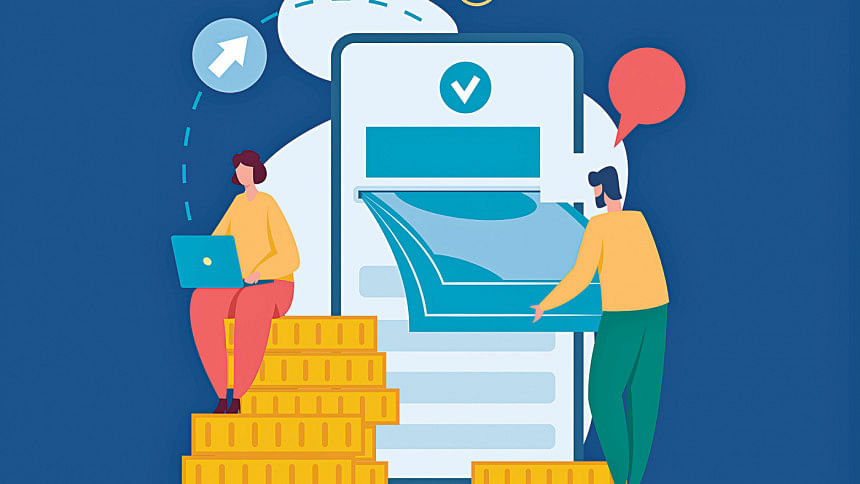The economic impacts of the 4IR on Bangladesh

Bangladesh is gearing up for the Fourth Industrial Revolution (4IR). Hardly a day goes by when a national political leader or a prominent civil society stalwart does not bring up the issues relating to 4IR in the national media. One could even say that 4IR is the new buzzword for the country.
There are many challenges and opportunities for us as we embrace this major global movement which, if handled adroitly, could lead to major transformation, growth and improvement. So, the million-dollar question is: What are the major policy actions that the government can initiate to prepare the country for 4IR?
What is 4IR?
First a caveat. While 4IR has the potential to "raise global income levels and improve the quality of life for populations around the world" according to Klaus Schwab, it also is not the be-all and end-all for the future of the globe. I say that because while the previous industrial revolutions in the last 200 years have left their indelible marks on society, the failure of the political, economic and social leaders to anticipate and steer clear of the negative side-effects—or landmines—have resulted in the current global crises, including climate change, income inequality, and the conflict-ridden landscape that we now witness.
The First Industrial Revolution used water and steam power to mechanise production, mostly in England. The Second harnessed the advent of electricity to create mass production, and an example could be Henry Ford's Model-T assembly line. The Third, which lasted from the end of the Second World War to the emergence of the Internet, used electronics and information technology to automate production. The Fourth, which is really at its infancy now, began with the use of artificial intelligence (AI), digitalisation, biotechnology, and global connectivity, and has touched the entire systems of production, management, and governance. Billions of people are now connected with mobile devices, and collaborate—using digital tools and AI—and live in a metaverse. 4IR promises to shape the future by linking the physical, digital, and biological worlds more tightly.
The promise and power of 4IR are evident in the world of the Covid-19 pandemic. New technologies will emerge more rapidly now that we know how to adapt to a major catastrophic event, and eventually address disease, climate change, and poverty.
Bangladesh's challenge is to transform our education programmes and skills development infrastructure to deliver the talents needed for an innovative, digitised, and post-agricultural economy as we also march into upper-income status.
The forces driving 4IR are various digital technologies including robotics, AI, virtual reality, blockchain, internet of things, nanotechnology, genomics, biotechnology, cloud computing, 3D printing, big data, and others. We can expect to see smart factories, cyber-physical systems, self-organisation, new systems in distribution and procurement, new systems in the development of products and services, adaptation to human needs, and corporate social responsibility.
Is Bangladesh prepared for 4IR?
Bangladesh is well situated to take advantage of 4IR. It has a growing manufacturing base, skilled manpower, and a creative entrepreneurial class. On the other side, the level of automation is still weak, the manufacturing sector is limited to garments and a few other minor industries, inadequate infrastructure and the institutions leave much to be desired. If Bangladesh wants to grab the opportunities arising from 4IR, it will need to put in place certain measures to overcome issues around accessibility, affordability, and the application of technologies in a fast-moving global environment.
Fortunately, our leadership is fully cognisant of the potential benefits of 4IR and the enormous tasks that lie ahead. The planning minister assured a gathering of business leaders that the government would provide full support for the formulation and implementation of a national strategy to make Bangladesh 4IR-responsive. The country is poised to review its progress periodically, having set specific growth targets for the years 2026, 2031 and 2041. To name a few, the country aims to graduate from LDC status in 2026, become an upper-middle-income country (UMIC) by 2031 and achieve high-income country status by 2041. In addition, there are 18 development targets to be achieved by 2030 under the UN's Sustainable Development Goals (SDGs).

Opportunities and challenges
Bangladesh has in the last 30 years gained significant knowledge in industrial growth to leapfrog directly into using more advanced technologies and bypass many of the early growing pains of adopting 4IR. Consequently, there are plenty of opportunities for transformation, growth, and improvement at all levels of governments, non-governmental organisations, and professions.
For example, during the Covid pandemic, our healthcare and IT sectors showed an extraordinary degree of adaptability, resilience, and engagement in the R&D ecosystem. The infrastructure needed for the health policy dissemination including vaccination, testing, and contact-tracing platforms were put in place in a short period of time.
In a UNIDO report entitled "Economics of Technological Leapfrogging", countries such as Bangladesh are identified as having the most promise in terms of leapfrogging into smart factories. The Bangladesh government has taken several initiatives in this regard, underscoring the need for leveraging information and communication technologies (ICT) to achieve its Vision 2041.
According to Oxford Internet Institute, Bangladesh is the second-largest supplier of online freelance labour. As an observer noted, "Urban life in Bangladesh is much more advanced in terms of transportation, banking, telecommunication, digital payments, e-commerce etc."
A precondition for joining the 4IR is having the absorptive capacity and basic technological capabilities for the businesses to capitalise on the opportunities that it presents. We also need to be mindful to shift our focus on building our capabilities to move into higher-end segments of existing global value chains.
An area that needs careful planning and public-private cooperation is the degree of automation appropriate for a country with excess labour. A recent study released by McKinsey Global Institute reports that roughly one-fifth of the global workforce will be impacted by the adoption of AI and automation. While the most significant impact of automation can be expected in developed nations like the UK, Germany, and the USA, emerging nations will not be safe. By 2022, 50 percent of companies believe that automation will decrease their numbers of full-time staff and by 2030, robots will replace 800 million workers across the world.

Professor Daron Acemoglu of the Massachusetts Institute of Technology (MIT), on the other hand, sees a silver lining. "It's not all doom and gloom," says Acemoglu. "There is nothing that says technology is all bad for workers. It is the choice we make about the direction to develop technology that is critical."
As Bangladesh attempts to upgrade the level of automation, the country will need to leverage local skills and training institutions. Given our nascent manufacturing base, we can also benefit from seeking out 4IR-related service start-ups with innovative business models or customising existing models to suit local conditions. Obviously, in such cases, access to initial financing and venture capital is crucial for small, medium, micro enterprises (MSME) to enter the market.
To take the case of RMG, it is possible to use blockchain technology to record, track, and trace garment shipments. Blockchains achieve bookkeeping without a bookkeeper and allow individuals to make transactions anonymously and quickly. Such innovative use of this emergent technology will provide consumer confidence about their source and compliance with safety and human rights best practices. Producers can receive an increased return on their labour, as consumers will then be ready to pay a premium for the end-product.
Organisations such as the Enhanced Integrated Framework, the International Trade Centre, the World Bank Group, the World Trade Organization and the World Economic Forum can provide software as well as hardware support to LDCs.
The role of government
The role of the government to usher in 4IR and to provide a suitable environment for that is pivotal. The education sector will also play a vital role in training the workforce needed for the new jobs. As mentioned, many of the existing jobs will be phased out and the laid-off workers will need to be retrained and the government can play a big role to provide the workers with the incentives to relocate.
Just as government policy was an important driver during the growth of the RMG sector in the 70s and 80s, the policy framework for 4IR must be tweaked to nudge the private sector and the universities to move in the right direction. Changes in the curriculum to steer our students in the direction of STEM (science, technology, engineering, and mathematics) must be initiated at the lowest level of the educational system.
To borrow a page from a global consultant's report, several steps need to be taken at the national level:
1. Make a plan. Set out the goals and work with the industry leaders to direct the latter into new kinds of technology to address customers' needs better.
2. Seek out new opportunities and the low-hanging fruits. Identify areas that are ready for change and lead to increased productivity.
3. Invest in human capital and manpower development to create a workforce that is ready to succeed in a digital environment.
4. Encourage all government agencies and the private sector to incorporate environmental responsibility and eco-efficiency. To compete successfully in the global environment, businesses need to pay more attention to reducing waste and using resources efficiently.
Concluding remarks
New technologies and 4IR can be instrumental in transforming our agriculture. The term industrial revolution is a misnomer since biotechnology and scientific research can boost our agricultural production and transform the lives of the rural population. Bangladesh has seen the spread of mobile technology, including mobile financial services making significant headway in rural areas. Software-enabled products provide real-time market information, on-time delivery of supplies, and faster transactions, and have already made inroads in remote villages.
Blockchain applications have the potential to transform the entire economy. Like railroads, electricity, telecommunications and the internet, blockchain technology could be a game changer. Blockchain databases have the ability to create and maintain decentralised marketplaces and distributed recordkeeping (land records, contracts, and legal transactions), and remove many institutional bottlenecks.
Dr Abdullah Shibli is Senior Research Fellow at the US-based International Sustainable Development Institute (ISDI). His new memoir, "A Fairy Tale: Autobiographical Stories", was recently published by Jonantik.

 For all latest news, follow The Daily Star's Google News channel.
For all latest news, follow The Daily Star's Google News channel. 



Comments